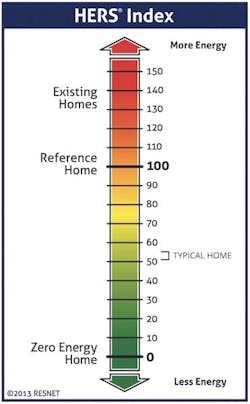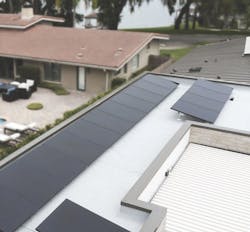Pushing Home Performance
The U.S. building sector accounts for approximately 48% of annual greenhouse gas emissions; residential construction accounts for half of that. The Environmental Protection Agency (EPA) estimates that a 25% reduction in the electricity used by residential and commercial buildings worldwide could, theoretically, avert 50 billion tons of emissions over the next half century. On a smaller scale, building a more efficient home or renovating to improve an existing structure’s efficiency means a healthier home for the people living there as well as reduced utility costs.
Drew Smith, COO of sustainable building consulting company Two Trails, based in Parrish, Fla., with another office in Las Vegas, has spent his career helping home builders across the country achieve those reductions (among other sustainability improvements) through home performance testing and advising. In business for 20 years, the firm focuses primarily on new construction but also consults on renovation and remodeling projects.
An authority in his field and a leader in the industry, Smith is an accredited LEED professional and energy auditor, certified by, among others, RESNET (Residential Energy Services Network), Home Innovation Research Labs, and the Florida Green Building Coalition—the latter of which, on three separate occasions, has named Smith Certifying Agent of the Year. Twice, the National Association of Home Builders has recognized him for his contributions to green and sustainable building—naming him Certified Green Professional of the Year in 2010 and Advocate of the Year in 2013. And, finally, Smith was not only the founding president of the Florida Green Building Coalition, he was also the state’s first governor-appointed green building commissioner.
We asked Smith to walk us through his process for testing a home’s energy performance, determining the best program for achieving energy goals, and assessing the cost to build a home that’s more energy efficient.
Testing a Remodeled Home vs. a New Build
Guided by experience, education, and a variety of sustainable building standards, the approach Smith and Two Trails take to improving and maximizing a home’s potential energy efficiency—whether a new build or remodeled home—is unique in that a home’s theoretical performance is challenged by testing efficiency factors, such as duct and envelope air leakage, wall R-values, insulation and window installation efficacy, and glass U-value and solar heat gain coefficients (SHGC) in real time. In the case of a remodel, tests conducted prior to construction give professionals additional insight into the impact improvements actually have on efficiency.
“On a remodel, especially one that involves an extensive demo, we like to come in before construction starts and do a performance test—what we call ‘preliminary HERS Index testing,’” Smith says. “Among other tests, it includes checking the existing ductwork’s pressurization and a blower door test, which will test the pressurization of the entire building envelope. That provides a snapshot of how bad or good the home’s energy efficiency may already be and a place from which to set benchmarks.”
Preconstruction performance testing, or “preliminary HERS Index testing,” will influence a project’s evolution and execution from overall scope to the selection of materials, systems, and appliances, he says. “We can, for example, see what effect switching from a shingle to a metal roof may have on performance.”
Understanding the HERS Index
The HERS Index or Home Energy Rating System is a performance evaluation tool created by RESNET, a national standards-making body for U.S. building energy efficiency rating and certification systems. The index is based on the 2006 International Energy Conservation Code and uses a scale to indicate a home’s energy efficiency (see illustration, left). Anything at the average rate or below (100 for a new house, 130 for a lived-in house) is pretty good. A score of 100 indicates a new house is built to code; that is, the home is at the same level as the HERS Reference Home (equivalent to the 2006 IECC). A score of zero means the home uses no more energy than it produces—a net-zero energy balance.
After consulting, Smith says, “we usually see scores in the mid- to low 50s, maybe 15% will be in the 40s”—the result of today’s building and energy code standards, which are more stringent than the 2006 IECC. “Some will hit above 65, though current codes make that uncommon,” Smith adds. But any movement along the HERS Index scale is significant.
According to Two Trails’ website, a single-point drop on the index corresponds to a 1% reduction in the energy consumption and a 1% improvement in the energy efficiency of the home.
Planning for Energy Efficiency
For new-home builders, preconstruction consulting on scope and materials can provide a strategy for achieving a particular level of energy efficiency, but the home’s overall performance won’t be measurable until construction is complete. Still, there are some areas of a build where actual performance can be (and is) verified as materials are being installed.
“We typically have two inspections,” Smith says. “One is pre-drywall, where we’re looking at the quality of the insulation installation, making sure the R-values are actually what we have in our calculations.” He also points out that while these checks verify material performance, they also ensure proper installation. “We want no air leakage. We’ll look at the caulking around the windows and the quality of installation, verifying efficiency values, checking performance against every window’s supposed solar heat gain coefficient and U-value.”
A Full Performance Review
As construction wraps up on a project, verifying overall energy performance is the last step in the Two Trails process, culminating with the calculation of a final HERS Index for the home.
At that point, the firm conducts a series of tests, such as pressurizing the ductwork to make sure it’s functioning properly and is still airtight after construction ends. “A lot of times, something is installed correctly, but then [as the build continues] you have people climbing through the attic, adding low-voltage wiring, or making some other change, and someone accidentally shakes the ducting loose,” Smith says.
Calculating overall home performance also includes a blower door test, which checks the building envelope for air leakage, and doing what Smith calls “energy checks.” “We’re looking for anything energy-related,” he says. “We verify the systems, any energy-related pumps, and the appliances installed—get the model numbers to check their exact electrical loads. We count light bulbs and fixtures to make sure what we’ve calculated is what’s actually installed.”
The results can be dramatic, such as with The Element House, a custom home in Sarasota, Fla., designed by Solstice Planning and Architecture and completed in late 2017. Two Trails was the LEED certifier for the home, which was a 2019 LEED Project of the Year Finalist, scoring -26 on the HERS Index. But home performance benefits are never more clear than with remodeling projects, which have the benefit of comparing the home’s existing and renovated energy use. That was certainly the case for The 2022 New American Remodel, on Lake Sue, in Orlando, Fla., which achieved a 143% reduction in energy consumption after project completion. “Our final HERS score for the home was -28,” Smith says. The 2022 New American Remodel is efficient to the point that it may add energy to the grid.
Price, Profit, and Performance
Pricing for the services provided by sustainability consultants, such as Two Trails, varies depending on project scope and the desired degree of energy efficiency. But, at its most basic, service costs are pretty consistent across projects and represent a relatively small line item in the project budget.
“HERS Index testing by itself, with no additional consulting services or certifications included, will typically cost less than $1,000,” Smith says. And, he adds, the return on investment (ROI) of HERS testing is potentially exponential, considering possible future savings on utilities and improvements to the homeowner’s quality of life. “That could amount to a $20,000 ROI,” Smith says.
The U.S. Department of Energy reports that improving or replacing a home’s heating and cooling system can result in annual utility savings of about $150, and transitioning from single-pane to more efficient glass for windows and doors will save a household upward of $583 in the first year. The EPA further reports that air sealing and insulation improvements alone can result in average energy savings of 15%, or $270 annually. If every home in the nation could reduce its utility bills by 15%, the collective savings in one year would top $32 billion.
More immediately, for homes built after Aug. 8, 2005, and sold or leased before Dec. 31, 2021, calculating a home’s HERS score can also help satisfy a contractor’s eligibility for the 45L tax credit—a $2,000 rebate per dwelling unit given to contractors to offset costs associated with building energy-efficient single-family or multifamily buildings. While that provision wasn’t extended into 2022 by Congress, other local and state tax benefits and utility rebates are often still available.
Rebate or no, Smith believes in the ROI of high-performance construction, namely energy savings that could cover the cost of testing in less than a year. RESNET estimates that, compared with the typical existing home, a remodel achieving net zero will save a homeowner $2,300 annually in utility bills. Compared with the average new home, a net zero custom build is estimated to save $1,800 annually.




